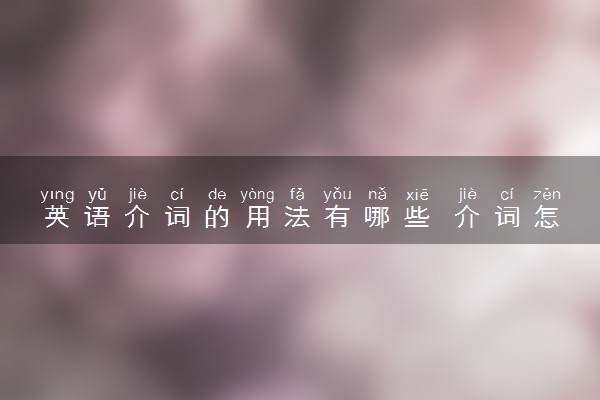专为高中生提供有价值的资讯
英语中介词后面必须跟名词、代替名词的代词、和名次共一样的动名词(-ing),以及名词短语、名词性从句---宾语从句。这就是介词的主要用法。

| 介词用途 | 例子 |
| 介词at, in, on, by 表示地方、地点、位置 | |
| at 把地方、地点、位置当作一个“点” | The begger is sitting at the corner. 那乞丐坐在角落里。 |
| in 把地方、地点、位置当作一个范围或一个封闭的空间 | I live in London. 我住在伦敦。(大城市用in) |
| on 把地方、地点、位置当作一个平面 | The author's name is on the cover of the book. 在书的封面上有作者的名 字。 |
| by 用在表示位置(有在旁、贴近、靠近之意) | by the seaside在海边 |
| at, in, on, by 用来表示时间 | |
| at (在、于)用指明一特定的时间、节日、年龄 | at dawn/ at night/at noon/ 在黎明/在夜里/在中午 |
| in (在、在…之内、在…期间、在…后、过…后) | in the afternoon 在下午 (在下午这段期间,呵呵,举一反三喔) |
| on (在…时、在(某日)、在某日早/午/晚、当…时候、和…同时、刚一…) | on the first在一号(指某月一号,如二号要说second等。其实意思是指某月的第 几天) |
| by (的时候、到、等到…已经) 用在天、时间 | by 2 o'clock到两点钟 |
| for, since 用于表示时间 | |
| 用 for 用计量时间(年、月、日、时、分、秒等) | He held his breath for five minutes.他闭息达五分钟。 |
| 用 since 表示明确的日期或时间 | He's woked here since 1980.自从1970年他就在此工作。 |
| 表示动作的介词:to ,toward或不用介词 | |
| 用 to 表示向某处移动 | They were driving to work together.他们一同开车去工作。 |
| toward 表示移向某处 | We're moving toward the light.我们向灯光处移动。 |
| 不需要介词的词:home, downtown, uptown | Grandma went upstairs. |
⑴ 时间或地点介词in、on、at的用法区别:表示时间时, in表示在一段时间里(在将来时句子中则表示在一段时间之后), on表示在具体的某一天或者某天的上下午等, at表示在某个时刻或者瞬间;表示地点时, in表示在某个范围之内, on表示在某个平面上或与一个面相接触,at则表示在某个具体的场所或地点.如:He was born on the morning of May 10th.(他出生于五月十日的早晨)/ I usually get up at 7:00 in the morning.(我通常在早上的七点钟起床) / His glasses are right on his nose.(他的眼镜就架在他的鼻子上)/ He is at the cinema at the moment.(此刻他正在电影院)
⑵ after与in表示时间的用法区别:“after+(具体时刻/从句)”表示“在…时刻之后”常用于一般时态;“in+(一段时间)”表示“在(多久) 之后”,常用于将来时态.如:He said that he would be here after 6:00.(他说他六点钟之后会来这儿)/ My father is coming back from England in about a month.(我父亲大约一个月以后从英国回来)
⑶ since与for表示时间的用法区别:“since+(具体时刻/that-从句)”表示“自从…起一直到现在”,“for +(一段斶间)”表示“总共有…之久”,都常用于完成时态;如:Uncle Li has worked in this factory since 1970.(李叔叔自从1970年起就在这家工厂工作了)/ Uncle Li has worked in this factory for over 30 years. (李叔叔在这家工厂已经工作了30多年)
⑷ by、in与with表示方式的用法区别:都可以表示“工具、手段”,但是by主要表示“乘坐”某个交通工具或“以……方式”,在被动句中可以表示动作的执行者;in表示“使用”某种语言/文字,with表示“使用”某个具体的工具、手段.如:We see with our eyes and walk with our feet.(我们用眼睛看东西,用双脚走路)/ Please write that article(文章) in English.(请你用英语写那篇文章)/ Let’s go to the zoo by taxi.(我们打的去动物园吧.)/ It was written by Lao She.(那是老舍写的)
⑸ about与on的用法区别:都可以表示“有关…”,但是about的意义比较广,而on主要表示“有关…(专题/课程)”.如:Tom is going to give a talk on the history of America.(汤姆要作一个美国历史的报告)/ They are very excited talking about the coming field trip.(他们兴致勃勃地谈论着即将来到的野外旅游)
⑹ through与across、over的用法区别: through指“穿过…(门洞/人群/树林)”; across和over可以指“跨越…(街道/河流)”,可互换,但是表示“翻过…”时只能用over. 如:Just then a rat (鼠)ran across the road.(就在那时一只老鼠跑过路面)/ There is a bridge across/over the river.(河上有座桥)/ They climbed over the mountain and arrived there ahead of time.(他们翻过大山提前到达了那里)/ The visitors went through a big gate into another park.(参观者们穿过一个大门来到另一个公园)
(7)as与like的区别:两个词都表示“像……”,但是as译为“作为……”,表示的是职业、职务、作用等事实,而like译为“像……一样”,表示外表,不是事实.如:Let me speak to you as a father.(我以父亲的身份和你讲话.)(说话者是听者的父亲) / Let me speak to you like a father.(让我像一位父亲一样和你讲话)(说话者不是听者的父亲)
(8)at the end of、by the end of、to the end、in the end的用法区别:at the end of…既可以表示时间也可以表示地点,译为“在…末;在…尽头”,常与过去时连用;by the end of…只能表示时间,译为“在…前;到…为止”,常用于过去完成时; in the end与at last基本等义,表示“终于、最后”,通常用于过去时;to the end译为“到…的终点为止”,前面往往有表示运动或连续性的动词.如:By the end of last term we had learned 16 units of Book III.(到上学期期末我们已经学习了第三册16个单元)/ At the end of the road you can find a big white house with brown windows.(在路的尽头你能找到一幢有棕色窗户的白房子)/ They left for Beijing at the end of last week.(上周末他们动身去了北京)/ In the end he succeeded in the final exams.(他最终在期末考试中考及格了)/ We should go on with the work to the end.(我们应该把工作干到底)/ Follow this road to the end and you will see a post office.(沿这条路走到底就能看见一家邮电局)
(9)for a moment、for the moment、in a moment、at the moment的区别:for a moment“一会儿、片刻”(=for a while),常与持续性动词连用;for the moment“暂时、目前”,常用于现在时;in a moment“一会儿、立即、马上”(=soon; in a few minutes),一般用于将来时;at the moment“此刻,眼下”(=now),用于现在进行时.如:Please wait for a moment.(请稍等)/ Let’s leave things as they are for the moment.(暂时就维持现状吧!) / I’ll come back in a moment.(我过会儿回来)/ I am very busy at the moment.(眼下我很忙)
(10)but的问题:用介词but引出另一个动词时,要注意:如果前面有do,后面就用原形动词,前面没有do时,后面的动词要加to.如:I could do nothing but wait.(我什么也做不了只能等) / They had no choice(选择) but to fight.(他们没有选择只有战斗)
(11)in front of 与in the front of: in front of“在…的前面”, 与in the front of“在…的前部”.如:A car was parking in front of the hall.(大厅跟前停着一辆汽车)/ In the front of the hall stood a big desk.(大厅前部立着一个大讲台)
(12)except (for)与besides的区别:except“除了”,表示排除掉某人物,即不包含;而besides“除了”则表示包含,即“不仅……又……”.如:Everyone went to the Palace Museum except Tom.(除了Tom,大家都去了故宫博物院)(Tom没有去故宫)/ Besides Chinese he also studied many other subjects.(除了汉语之外,他还学其他许多功课)(“汉语”也是他学的功课之一)
other than 除了.之外. There 're nobody here other than me 与.不同. 与.不同方式.we can't get there other than by swimming.
Apart from : with the exception of ...; besides... Apart form a few scratches, the car was undamaged
Copyright 2019-2029 http://www.laigaokao.com 【来高考】 皖ICP备19022700号-4
声明: 本站 所有软件和文章来自互联网 如有异议 请与本站联系 本站为非赢利性网站 不接受任何赞助和广告